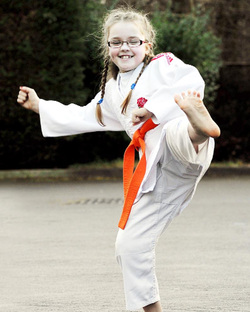
A YOUNG judo fighter who dreams of competing in the Paralympics has been hailed an ‘inspiration’ by a leading blind charity.
Caitlin Leigh, who has glaucoma and is registered blind, competes against fully-sighted youngsters and recently scored her first victory.
The 10-year-old, of Leopold Way, Blackburn, took up the sport five years ago after struggling to take part in ball-based sports and her mum is delighted by the huge confidence boost it has given her.
Claire, 32, said: “In judo you are grabbing hold of people pretty much the whole time so it’s much better suited for her.
“She’s absolutely loved it and was over the moon when she won her first fight. We’d been to about five tournaments and she had tears in her eyes and ran over to her dad and gave him a big hug.
“The great thing about it is she’s not treated any differently and she’s made some great friends.
“We took her to see the judo at the Paralympics in London last year and that just fuelled it even more. It’s her ultimate goal to compete at the games one day.”
Caitlin, a pupil at St James Primary School in Lower Darwen, has no vision in her left eye, and her right eye is extremely short sighted. She reads braille and uses a cane to walk.
She first tried the sport at a taster session run by the Action for Blind People Actionnaires Club in Blackburn and enjoyed it so much she joined Beach Judo Club in Westbury Gardens as well as Shadsworth Judo Club. She trains twice a week and now competes regularly, recently achieving her orange belt.
The order of grades generally sees fighters progress from orange to green, blue and brown before black.
Janet Beale, a support coordinator at Action for Blind People, said: “Caitlin is an absolute inspiration to other youngsters with sight problems.
“She’s been a regular at our sessions and doesn’t seem to let anything get in her way. We gave her the confidence to try something different and that’s what it’s all about. Blindness shouldn’t be a barrier to taking part in sport.”
Caitlin Leigh, who has glaucoma and is registered blind, competes against fully-sighted youngsters and recently scored her first victory.
The 10-year-old, of Leopold Way, Blackburn, took up the sport five years ago after struggling to take part in ball-based sports and her mum is delighted by the huge confidence boost it has given her.
Claire, 32, said: “In judo you are grabbing hold of people pretty much the whole time so it’s much better suited for her.
“She’s absolutely loved it and was over the moon when she won her first fight. We’d been to about five tournaments and she had tears in her eyes and ran over to her dad and gave him a big hug.
“The great thing about it is she’s not treated any differently and she’s made some great friends.
“We took her to see the judo at the Paralympics in London last year and that just fuelled it even more. It’s her ultimate goal to compete at the games one day.”
Caitlin, a pupil at St James Primary School in Lower Darwen, has no vision in her left eye, and her right eye is extremely short sighted. She reads braille and uses a cane to walk.
She first tried the sport at a taster session run by the Action for Blind People Actionnaires Club in Blackburn and enjoyed it so much she joined Beach Judo Club in Westbury Gardens as well as Shadsworth Judo Club. She trains twice a week and now competes regularly, recently achieving her orange belt.
The order of grades generally sees fighters progress from orange to green, blue and brown before black.
Janet Beale, a support coordinator at Action for Blind People, said: “Caitlin is an absolute inspiration to other youngsters with sight problems.
“She’s been a regular at our sessions and doesn’t seem to let anything get in her way. We gave her the confidence to try something different and that’s what it’s all about. Blindness shouldn’t be a barrier to taking part in sport.”
 RSS Feed
RSS Feed